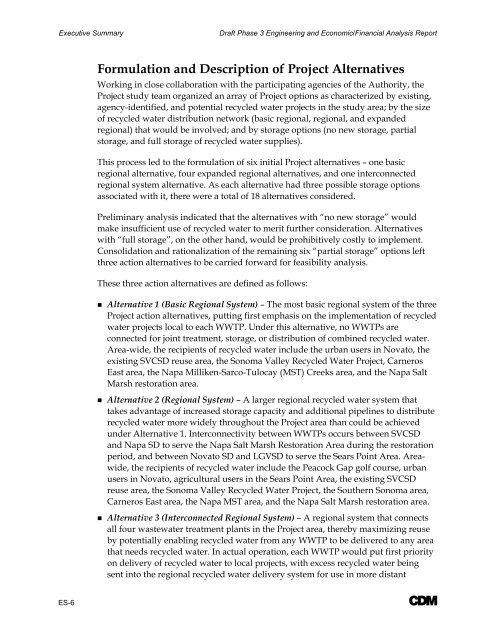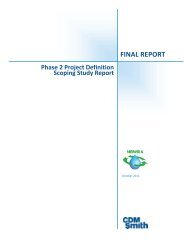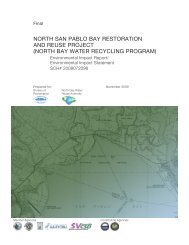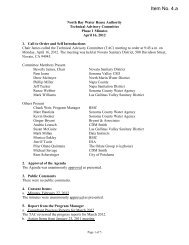Phase 3 Feasibility Report (Table of Contents & Executive Summary)
Phase 3 Feasibility Report (Table of Contents & Executive Summary)
Phase 3 Feasibility Report (Table of Contents & Executive Summary)
You also want an ePaper? Increase the reach of your titles
YUMPU automatically turns print PDFs into web optimized ePapers that Google loves.
<strong>Executive</strong> <strong>Summary</strong><br />
Draft <strong>Phase</strong> 3 Engineering and Economic/Financial Analysis <strong>Report</strong><br />
Formulation and Description <strong>of</strong> Project Alternatives<br />
Working in close collaboration with the participating agencies <strong>of</strong> the Authority, the<br />
Project study team organized an array <strong>of</strong> Project options as characterized by existing,<br />
agency-identified, and potential recycled water projects in the study area; by the size<br />
<strong>of</strong> recycled water distribution network (basic regional, regional, and expanded<br />
regional) that would be involved; and by storage options (no new storage, partial<br />
storage, and full storage <strong>of</strong> recycled water supplies).<br />
This process led to the formulation <strong>of</strong> six initial Project alternatives – one basic<br />
regional alternative, four expanded regional alternatives, and one interconnected<br />
regional system alternative. As each alternative had three possible storage options<br />
associated with it, there were a total <strong>of</strong> 18 alternatives considered.<br />
Preliminary analysis indicated that the alternatives with “no new storage” would<br />
make insufficient use <strong>of</strong> recycled water to merit further consideration. Alternatives<br />
with “full storage”, on the other hand, would be prohibitively costly to implement.<br />
Consolidation and rationalization <strong>of</strong> the remaining six “partial storage” options left<br />
three action alternatives to be carried forward for feasibility analysis.<br />
These three action alternatives are defined as follows:<br />
• Alternative 1 (Basic Regional System) – The most basic regional system <strong>of</strong> the three<br />
Project action alternatives, putting first emphasis on the implementation <strong>of</strong> recycled<br />
water projects local to each WWTP. Under this alternative, no WWTPs are<br />
connected for joint treatment, storage, or distribution <strong>of</strong> combined recycled water.<br />
Area-wide, the recipients <strong>of</strong> recycled water include the urban users in Novato, the<br />
existing SVCSD reuse area, the Sonoma Valley Recycled Water Project, Carneros<br />
East area, the Napa Milliken-Sarco-Tulocay (MST) Creeks area, and the Napa Salt<br />
Marsh restoration area.<br />
• Alternative 2 (Regional System) – A larger regional recycled water system that<br />
takes advantage <strong>of</strong> increased storage capacity and additional pipelines to distribute<br />
recycled water more widely throughout the Project area than could be achieved<br />
under Alternative 1. Interconnectivity between WWTPs occurs between SVCSD<br />
and Napa SD to serve the Napa Salt Marsh Restoration Area during the restoration<br />
period, and between Novato SD and LGVSD to serve the Sears Point Area. Areawide,<br />
the recipients <strong>of</strong> recycled water include the Peacock Gap golf course, urban<br />
users in Novato, agricultural users in the Sears Point Area, the existing SVCSD<br />
reuse area, the Sonoma Valley Recycled Water Project, the Southern Sonoma area,<br />
Carneros East area, the Napa MST area, and the Napa Salt Marsh restoration area.<br />
• Alternative 3 (Interconnected Regional System) – A regional system that connects<br />
all four wastewater treatment plants in the Project area, thereby maximizing reuse<br />
by potentially enabling recycled water from any WWTP to be delivered to any area<br />
that needs recycled water. In actual operation, each WWTP would put first priority<br />
on delivery <strong>of</strong> recycled water to local projects, with excess recycled water being<br />
sent into the regional recycled water delivery system for use in more distant<br />
ES-6<br />
A








